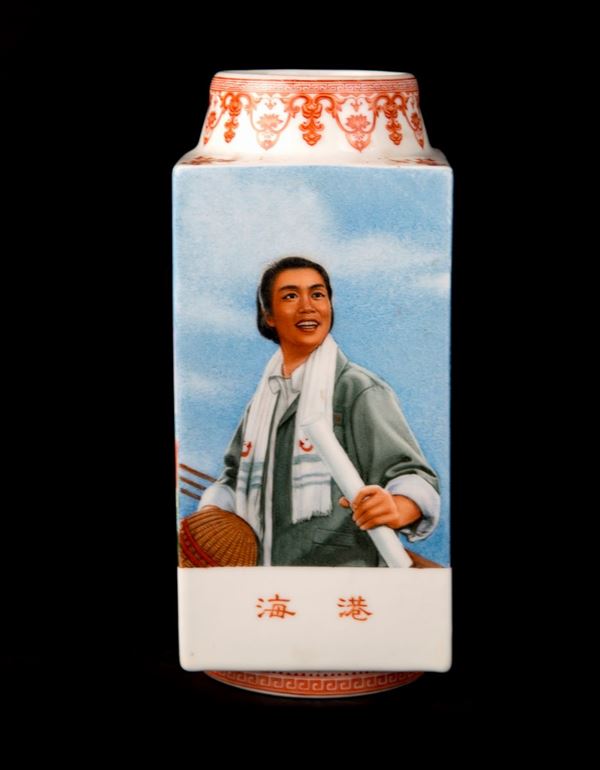RARE 'CONG' VASE PAINTED WITH PROPAGANDA SUBJECTS OF THE CHINESE CULTURAL REVOLUTION, China, People's Republic of China (1949 - present)
Archaic in form, with a circular mouth and tapering neck decorated with a fine band with floral motifs in iron red, the square body is well painted on each face with polychrome enamels with a character and with inscriptions in iron red; the low ring-shaped foot is decorated with a Greek also in iron red. The centre of the base bears an eleven-character mark in iron red that reads 'Respectfully Painted by the Art Porcelain Factory for the Revolutionary Committee' (藝術瓷廠革命委員會敬絵).
Provenance: -Private collection, Europe.
Catalogue notes: The word 'Cong' is an archaic term and refers to a rectangular jade ritual vase with a round mouth, this form is one of the most famous in Chinese culture and has been taken up by almost all dynasties up to the present day.
This vase is noteworthy for its extraordinary pictorial quality on a porcelain from the People's Republic of China period; the characters depicted are taken from works extolling Chinese Communist Propaganda in the second half of the 20th century; each work taken up is part of the 'Eight Model Works' approved by the Communist Party, as well as the 'Red Classics':
1-"Ode to Longjiang" (Longjiangsong, 龍江頌),
2-"On the Quays" (Haigang, 海港)
3-"Fighting on the Plain" (Pingyuanzuozhan ,平原 作戰)
4-"The Taking of Tiger Mountain" (Zhiqu Weihushan , 智取 威虎山)
Among the top ten porcelain factories in Jingdezhen, the Art Porcelain Factory is one of the best known names in the city, having operated in the market since 1958, the year of its foundation, exerting considerable influence until 1998, when it closed for renovation. As porcelain manufacture was managed by the state, official rules were established for the production of each company, each of which had its own role. The Art Porcelain Factory concentrated on exhibition porcelain and coloured handmade porcelain. It was commissioned various works by the Party and the Revolutionary Committee, an indication of the prestige it enjoyed in the second half of the 20th century.
















